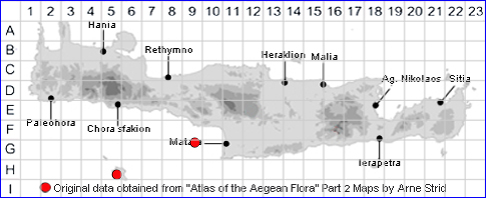
SPECIES DESCRIPTION
SILENE FRUTICOSA
Family:- CARYOPHYLLACEAE/Sect. SIPHONOMORPHA
Common Names:- None
Synonyms:- Silene carnea.
Meaning:- Silene (Gr) A name used by the Greek philosopher Theophrastus for
catchfly.
Fruticosa (L) Of shrub-like habit.
General description:- Much-branched, robust perennial, almost completely
Stems:-
1) 10-30 cm, rather stout, flowering stems acsending to erect subglabrous below ±
glandular-pubescent above.
Leaves:-
Flowers:-
3) Petal-limb, 8-15 mm, shortly bilobed white to yellowish rarely pink above.
4) Anthophore 8-10 mm.
Fruit:-
2) Seeds, 1·5-2 mm, acutely tuberculate, blackish.
Key features:-
1) Flowers large, hermaphrodite.
2) Petals usually distinctly bifid.
1 branch with a 3- or more-flowered dichasium.
4) Capsule less than 1½ times as long as the carpophore.
5) Plant glabrous.
6) Calyx more than 20 mm.
7) Petals red.
8) Inflorescence short.
Habitat:- Crevices of coastal limestone cliffs, rarely in gravelly or ruderal habitats.
0-300 (-600) m.
Distribution:- S Peloponnisos, - Scattered in the C & E Mediterranean region:
Sicilly, Malta, Libya, Egypt, S Greece and Cyprus absent from Anatolia. Rare on
Crete, currently known only from the islands of Paximadia and Gavdos SW of
Crete.
Flowering time:- Apr-June.
Photo by:- Courtesy of Wiki-Common
GLOSSARY OF TERMS USED
Acute:- Sharp, sharply pointed, the margins near the tip being almost straight.
Anthophore. A stalk-like extension of the receptacle on which the pistil and corolla
are borne.
Apiculate:- Ending in an abrupt, short point.
Beak:- A prominent terminal projection, especially of a carpel or fruit. adj. beaked
Bifid:- Divided at the tip in two (usually equal) parts by a median cleft
Calyx:- A collective name for the sepals - the outer whorl of organs in most flowers.
Capsule:- Dry fruit that opens when ripe. splitting from the apex to the base into
separate segments known as valves.
Carpophore:- The fruit bearing stalk A prolongation of the receptacle or floral axis
bearing the carpels or ovary.
Ciliolate:- Having cilia..
Corolla:- A collective name for the petals.
Coronal-scale:- One of the ring of scales on th inner surface of the corolla, as at
the junction of the limb and claw in some sllene species.
Dichasium- (pl Dichasia):- Cyme with lateral branches on both sides of the main
axis.
Glabrous:- Without hairs, hairless.
Hermaphrodite:- Having both male and female organs in the same flower.
Inflorescence:- The flowering branch or branches, flowers and bracts above the
uppermost leaves on a stem.
Laciniate:- Cut into slender lobes or drawn-out teeth.
Ovoid:- Egg-shaped.
Panicle:- A loose, branching cluster of flowers.
Patent:- Spreading.
Peduncle:- The stalk of an inflorescence or partial inflorescence.
Petal:- The inner perianth segments when they clearly differ from the outer.
Petal-limb:- An enlarged upper part of the petals.
Raceme:- A spike-like inflorescence in which the individual flowers are stalked.
Racemose:- Taking the form of a raceme.
Retrorse - Turned backward, turned downward.
Retrorsely:-Ciliolate:- Having cilia, turned backward, turned downward.
Spatulate-Spathulate:- Paddle-shaped, oblong with an extended basal part.
Subglabrous:- Almost without hairs.
